How To Cook Dried Beans – A Staple of Plastic-free Living
My friend Katie from Kitchen Stewardship just released a new e-Book this year, The Everything Beans Book, and she’s giving readers of this blog a 20% discount through 4/15 (coupon code 20BEANSBK). I’m excited about Katie’s latest book because learning how to prepare and cook dried beans is crucial when you’re trying to live a plastic-free life. Why? Because dried beans are a great source of protein we can purchase plastic-free from bulk bins using our own bags and containers.
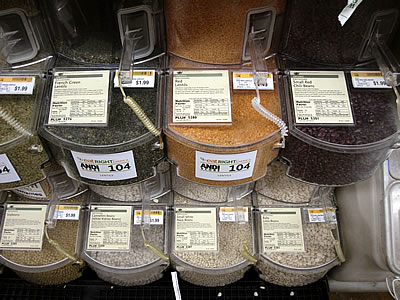
Canned beans, on the other hand, are problematic because most metal cans are lined with plastic which contains BPA, a hormone-disrupting chemical. And for me, even the new BPA-free cans are suspect because we really don’t know if the new linings are any safer than the old ones. Chemical companies don’t reveal their “trade secrets” and consumers are left in the dark.
But preparing dried beans is so hard, right? Wrong. While it does require planning ahead, it’s not hard. And by making up big batches and freezing in glass jars, you can have beans ready when you need them. In her book, Katie outlines three different methods for soaking and cooking beans, and explains the nutritional benefits of longer preparation times. And like her Healthy Snacks to Go e-book that I wrote about last year, this book is just as well organized and easy to understand.
But how are the recipes? Well, this week I decided to give one of them a try. I picked Tuscan Bean Soup because it’s rated as easy, is easily vegan, and I already had the ingredients in the house: white beans, olive oil, spinach, garlic, herbs, and stock. Katie’s recipe calls for chicken stock, but I used my handy Better Than Bouillon veggie broth instead.
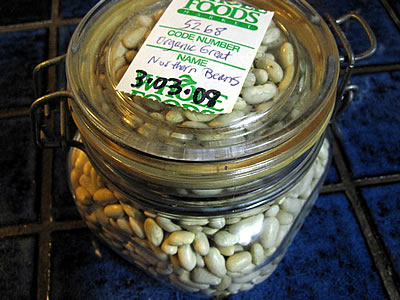
I soaked them for over a day.
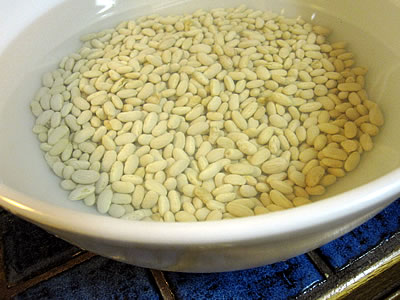
And cooked them for several hours while writing up my Pepsi bottle post.
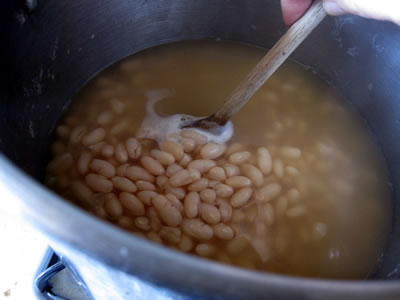
To make Katie’s recipe even easier, I didn’t bother with sauteing onions and garlic separately. No, since I already had the beans cooking on the stove, I just dumped all the ingredients except the spinach into the water the beans were already cooking in and let the whole thing simmer. (Note: I added these ingredients AFTER the beans were done cooking.) Then, per Katie’s instructions, I removed 2 cups of beans, pureed the rest up in my blender, and replaced the whole beans. Pureeing gives a nice thick texture to the soup, which turned out seriously delicious. I added the spinach at the end and ate my soup with fresh sourdough bread from the bakery down the street. Awesome.
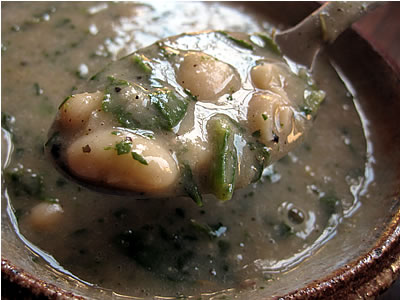
The Everything Beans Book includes 30 original recipes, including a recipe for bean brownies! Vegans and vegetarians be warned: Katie is not a vegetarian, and many of the recipes in The Everything Beans Book include meat and dairy products. But all of them can be easily modified, as I modified the recipe above. For me, the most useful thing about this book is the information about preparing beans. Katie even recommends soaking beans like lentils and split peas — beans you wouldn’t ordinarily think about soaking — and she explains why.
As I mentioned when I reviewed Katie’s Healthy Snacks to Go e-book, I am an affiliate, which means that when you purchase one of her e-books through this site, My Plastic-free Life makes a small commission, which pays for things like web hosting and field trips to exotic locations like recycling centers, plastic bag factories, conferences, and the like. So you’re not only getting a great book but also the warm happy feeling of knowing you’re helping keep the plastic-free work going.
This week, through midnight 4/15, you can use the coupon code 20BEANSBK to get 20% off the regular price. Click here to order The Everything Beans Book.









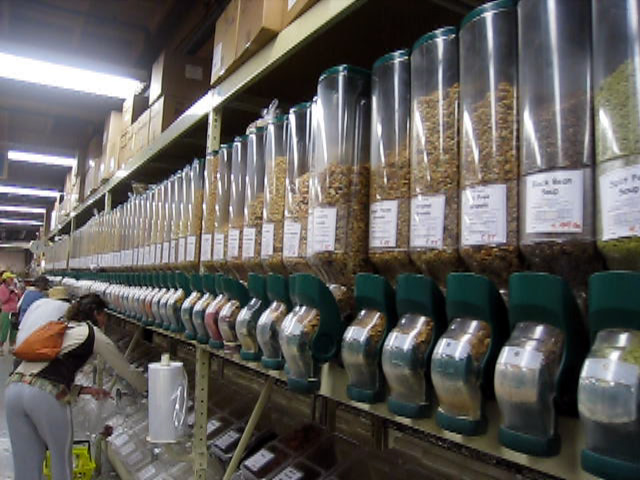
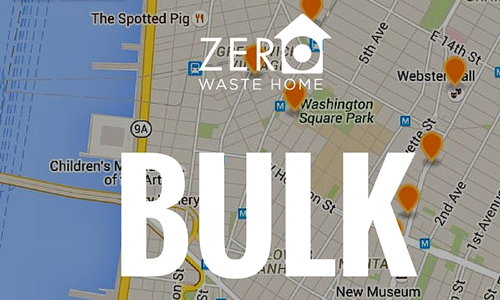
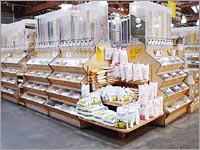

Love the beans, hope Whole Foods gets away from using plastic bins too.
Nice article for Environment aware(Esp.Plastic) and to purchase our product in plastic free bags.
I am working on my plastic consumption. I love seltzer. I make all kinds of concoctions starting with the dreaded bottle of plastic seltzer. Is switching to CO2 canasters any better for the environment? The little CO2 canaster is only good for a single use and I cannot find someplace to refill them. My thought is that you can recycle the steel canaster but……..
you can recycle plastic also.
Hi, Karen. There are two kinds of soda makers, the kind that use little single-use throw-away cartridges vs. the kind that use big CO2 canisters that last for a long time and then are exchanged for a new one. I have the latter kind. Read my blog about it:
http://myplasticfreelife.com/2008/07/my-happy-penguin/
I soak my lentils for making sweet potato curry and they definitely taste better then not soaking them. I was introduced to the concept of soaking beans in a mason jar in the fridge by my younger brother who makes his own refried beans (easier then it sounds) and it has changed my eating habits drastically. Rather then freezing them, I just put a mason jar with half beans, half water in my fridge a few days before I plan on making a meal.
And while we’re mentioning steps that no one has mentioned… I always make sure to sort the beans by hand before soaking/cooking. There are always a few moldy or rotten ones and a few clods of dirt and even small rocks. And while I love the story of stone soup, I don’t really want to take it that far! Seriously though, it makes a huge difference in the taste.
just wanted to throw this in, that i noticed no one is mentioning a lot of rinsing in between the soak and the cook-forever steps. i think it’s for removing the phytic acids that make it harder for our bodies to digest. first you soak to get that stuff out, but then it’s in the soak water so you rinse three times, add a new bacth of water THEN cook forever. :)
I read Kitchen Stew quite a bit myself. We switched to dried beans a few years back b/c of BPA concerns. Such a great food storage item too, and so cheap! We make them in the pressure cooker, and then add a bit more stuff in a la Colombian style (a friend showed us her way while we were visiting family in Bogota). They are yum and I should post the recipe (very simple) someday.
I wish I had won Kitchen Stew’s book. I would love to see her recipes, but am SO cheap. Wish I could get it at the library! We mostly make lentils, pintos, and black beans around here, all in a similar South American style.
Wow–you guys have such fascinating comments! Thank you, Beth, for your response, and thank you everyone else for your neat info! I am NOT young but I suffer from a great deal of kitchen intimidation (AND I simply don’t have much time to cook), so all this is wildly helpful! : )
Fascinating… I wonder what else Laurel’s wrong about!
It’s quite the opposite. Not only does soaking make the beans more palatable and easiliy digested, it also increases the availability of the nutrients. If you change the water a few times during the soaking, they will begin to sprout, which is even better.
DC – Thanks for the info on Kombu being for digestion purposes… very interesting. And I think I agree about the whole isolated nutrient thing.
BTW – until recently I’ve never soaked beans because Laurel’s Kichen (my cooking bible) says that you lose nutrients that way. But recently, on the advice of Melissa over at Her Green Life https://hergreenlife.com/2011/03/11/brine-your-beans/ I tried soaking them in salt water before cooking them with great results. They were much tastier than usual and much less gas producing.
Anybody know anything about how many nutrients you lose by soaking them? Just wondering if it’s worth the trade off or not.
I was wondering what to use for freezing large amounts of cooked things (tonight’s leftover chili) and you’ve already answered my question. My engineer husband is going to have a small fit but I’m getting out the mason jars.
thanks for the heads up on the book…will check into that. your soup looks delish!
Beth, the article on MSG you linked to was really interesting. I think it is a misunderstanding to say that kombu is “the same as” MSG. As the article mentioned glutamate is in almost everything.
I think this makes a really good case for unprocessed foods. Nutrients don’t naturally come in isolation. They come packaged with all sorts of cofactors, enzymes, and other molecules that effect the way the body absorbs them. These days it’s popular to figure out the active constituent of any food or herb that helps us, and take it in isolation, when it’s often expensive and doesn’t work as well in isolation.
Also, more is not always better. So, the amount of glutamate from one strip of seaweed is unlikely to bother anyone, while the amount from pure MSG is more than the body can handle. (Anecdotally, I’ve found this to be true)
And finally, we have to consider the by products of processing. The article said MSG is derived from wheat, a common allergen, and who knows what else they use. I’m reminded of the DHA in baby formula these days that has residue of the hexane they use to make it. Down with processed foods!
No, the kombu *is* to make it easier to digest
Thought I’d put my two cents in about soaking and cooking…
I soak my beans, ALL of them, lentil and peas included, because it does help in the digestion of them. I add a generous amount of ginger powder and change the water every 12 hours for 24 to 36 hours. Then I cook the beans with a whole carrot, unpeeled, until the whole soup is done. I remove the carrot and compost it. I have no idea if the additives work, or if it’s just changing the water or soaking time, but I don’t have digestive issues most of the time. :)
Funny how we all try to get the bean issue under control… I wonder why there isn’t a set rule of thumb?
I”m pretty sure it’s for flavor enhancement.
I got the part about putting the Kombu in the beans… I’m just trying to figure out why. Is it for flavor or to make them less gassy somehow? Just curious…
I rehydrate beans for the kids in the slowcooker – set on low for 6 hours, and checking every few hours to see if more water needs to be added. Adding a clove or smashed garlic or a few sprigs of savoury spice to the water seems to help make the beans easier to digest, and the kids less gassy.
CROCK POT! I have found that to be the easiest thing ever and it doesn’t require pre-cooking. And I have found lazier and lazier ways to make them too – the other day, I used a mini crock-pot, added 1 cup of black beans (I grew up on those – my mom was Brazilian) and water to top up the crock pot (I think it’s only a quart), plus an unmeasured but generous amount of creole seasoning, and 5 hours later with zero effort from me – delicious black beans.
I also use a larger crock pot to make lentil soups and split pea soups. So perfect – one pot and it’s pretty impossible to mess anything up. You don’t have to be there while it’s cooking, and if you have an immersion blender, soup is absurdly easy. I’ve also made chick peas for hummus and falafel (not as hard as you’d think!) I got into dried beans for cheap protein in the first place, but the no-added-plastic-or-chemical-crap aspect is pretty awesome too. And for anyone who has ever bought a $3 can of Progresso, you can make a whole pot of way tastier soup for the same price. I prefer less salt, more season, so that’s how I make it.
I don’t know when I came a crock pot evangelist. But the boss pulled BBQ chicken and LASAGNA maybe sealed the deal (that’s not one dish, the lasagna is a separate entity from the chicken.)
I drank a lot of coffee before this post. Maybe you can tell.
Well, it sounds like your book would probably tell you not to do this, but I saute the onions and garlic first (yes, it makes a huge difference in flavor) and then cook my beans right on top. So I also don’t use a second pot. Guess I’m going to have to read the book to find out why that’s a no-no! :)
BTW – That’s a fascinating article about MSG (kombu) but what on earth does this have to do with soaking beans. What am I missing?
Read Anna’s comment above. She said she uses a strip of kombu in her beans.
Beth, you are so good at writing these teaser sorts of posts… just enough info to get us curious, but with plenty of unanswered questions so we’ll all want to buy the book. And if it weren’t for the fact that I’m busy spending my life’s savings on medical care for wayward cats, I might consider dropping a few bucks on this one.
Now… I fear this comment may make me sound like a foodie snob (an idea which you would find totally laughable if you could see the vomit-like appearance of the concoction that I have created this evening) but…
You might want to try sauteing the onions and garlic separately, not because they will ge any more thoroughly cooked that way, but because flavors are generally carried in the oils, and sauteeing your most flavorful ingredients in oil helps them to propagate throughout the entire dish – at least that’s what I’ve read. And my experience (vomit-like appearance notwithstanding) has been that when you sautee the onions, garlic and spices you do significantly enhance the flavor of the overall dish.
God, EcoCatLady, what a foodie snob you are. I know you’re probably right. But I’ll sacrifice a little extra flavor for one less pot I have to wash. :-)
I make beans all the time, but I use a strip of kombu since beans and I don’t always get along. BTW, some people use a whole potato. The longer you soak the beans, the easier it is to digest. I started to soak mine for 72 hours and change the water every day. I use the bean water for my plants.
Often times, I make more than enough beans so I store the rest with the liquid in glass jars in the freezer. The quickest way is to use a pressure cooker, which cooks the beans in about 15 minutes.
By the way, Split peas and lentils don’t have to be soaked.
Growing beans is so easy if you have the room and don’t have a ground hog. I grew black beans and black eye peas. I attempted to grow soy until the ground hog found them. He thought the leaves tasted pretty good. So good, he didn’t leave any leaves so the plants couldn’t thrive.
Hi Anna. I’ve never soaked split peas and lentils either, but Katie gives reasons in the book why it’s a good idea to soak those beans too.
Anna, I had heard that kombu was the same as MSG. So I looked it up and found this really interesting article about the history of MSG and its origins from natural kombu. https://www.theguardian.com/lifeandstyle/2005/jul/10/foodanddrink.features3 Now I don’t know what to think.
Hi Beth! Thank you so much for this post (and your blog)! I am trying to live more plastic-free, and wow is it tough. I bought mason jars a few years ago to store stuff in the fridge, and glass freezer containers, but I am wondering–what glass jars do you use for freezing? I am concerned about using canning jars because unless glass is specifically made for the freezer, it can shatter in the cold. Thoughts? Thanks!!
: )
PS–I will be sifting through the rest of your blog to get more info. The toughest thing in the WORLD is buying food–everything is packaged in plastic!!
Hi Lisa. It’s actually fine to use mason jars for freezing. I do it all the time. In fact, Katie even mentions mason jars as an option for freezing beans in her book. The trick is 1) don’t fill it all the way to the top 2) let it cool down some before putting in freezer 3) don’t heat it up too fast when you take it out. I’ve never had one break on me.
If you want to put something really hot in a glass container, put a piece of silverware in first and then pour the hot food in. I do this regularly (almost 80 years) and have never had a glass container break.